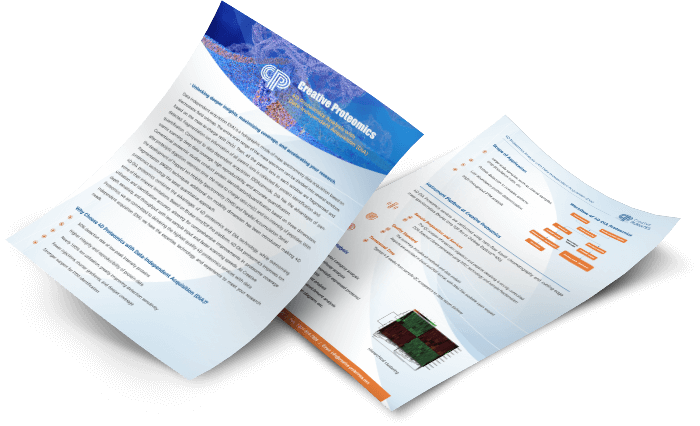Super Reaction Monitoring-SRM™ Quantitative Proteomics Services
Super Reaction Monitoring (SRM™) is a label-free next-generation proteomics technology platform established by Creative Proteomics. This platform combines Data-Dependent Analysis (DDA) and Data-Independent Acquisition (DIA) technologies to obtain data before each analysis. Shortcomings of DDA and selected reaction monitoring (SRM) in terms of depth and width that have limited researchers from examining complex biological systems are address by SRM™. The platform also allows an unmatched proteomics coverage with accurate and reproducible quantification of thousands of proteins per sample.
- Construction of spectral database: Spectral database built from the DDA runs on the experimental samples or samples of interest. The spectral database is a non-redundant set of MS/MS spectra, serving as a template for peptide identification during data analysis.
- Data collection in DIA mode: DIA experiments are conducted on a combined system with full scan data being recorded in a time-of-flight (ToF), Orbitrap or other high-resolution mass analyzers. Under the DIA model, nearly all detectable proteins (including low abundance proteins) can be quantitatively identified with high accuracy and repeatability.
- Data analysis: The obtained data were matched and quantified by the accurate template peptide spectra from the spectral database. The most advanced algorithms are used in our OpenSWATH and Skyline software.
Tailored Solutions to Meet Your Needs
- For large-scale proteomics projects: This is a standardized SRM™ platform with a special database built from the DDA and the fast turnaround time. Thousands of proteins can be duplicated and precisely quantified from one sample. This option is for customers looking for reliable and rapid solutions to quantify proteome changes in their samples.
- For comprehensive proteomic analysis: Featuring an extended LC gradient for a deeper analysis and identification of more proteins, this option is for customers looking for an in-depth proteome quantification service.
- For the most extensive proteome profiling research: Equipped with the most advanced high-resolution mass spectrometer instruments and an ultra-long LC gradient, this solution maximizes the depth of the analysis and identifies the highest numbers of proteins. This is for customers looking for projects with the highest proteome coverage on the market.
- For rapid screening for large projects: We provide a unique solution for researchers in large studies with hundreds of samples who are looking for a reliable and fast service to quantify proteome changes on a large scale. This scheme features a shorter LC gradient which results in a faster turnaround time per sample.
Workflow
.png?v=20191014)
Analytical Platform
AB SCIEX Triple-TOF 5600-plus, Q-Exactive, Orbitrap Fusion
Bioinformatics Analysis
| Problems to be Solved | Bioinformatics Analysis |
| Quality Assessment of Protein | DIA Data Analysis |
| Protein Comparison of Different Samples | Multivariate PCA Analysis |
| Protein Statistical Analysis | Venn Diagram |
| Volcano Plot |
| Functional Annotation | KEGG Annotation |
| GO Annotation |
| COG Annotation |
| Clustering Analysis | Hierarchical Clustering |
| K-Means Clustering |
| Network Analysis | STRING Analysis |
Key Features
- Combine the advantages of DIA and DDA: based on DDA database and DIA analysis technology
- High throughput: Identify and quantitate up to thousands of proteins at once
- High accuracy and repeatability with second order mass spectrometry signal quantification and DIA based database
- Quantitatively identify nearly all detectable proteins, including low abundance proteins
Sample Requirements
Based on our special protein extraction technology, we can quickly extract proteins from various samples and design personalized experimental schemes according to different experimental purposes. Specific requirements are as follows:
| Sample Type | Protein | Cell | Animal Tissue | Plant Tissue | Blood | Urine | Serum | Microbes |
| Quantify | 100 ug | 1×107 cells | 1 g | 200 mg | 1 mL | 2 mL | 0.2-0.5 mL | Dry weighed: 200 mg |
Note:
- Please prepare enough dry ice or ice packs to ensure low temperature during sample delivery.
- Our service is for research use only and is not intended for diagnosis.
Applications
- Large-scale quantitative analysis of protein
- Biomarker discovery and validation
- Target discovery
- Mechanism and regulation mechanism research
- Pathological study of disease
- Genetic association study
- Microorganisms proteomic research
- Crop proteomics research
Reports
- Experiment report
- Relative parameters of the mass spectrometer
- MS raw data files
- Bioinformatics analysis
- Peptide/Protein identifications and intensities
Learn more about SWATH and MSX-DIA.
* For Research Use Only. Not for use in the treatment or diagnosis of disease.

.png?v=20191014)

 4D Proteomics with Data-Independent Acquisition (DIA)
4D Proteomics with Data-Independent Acquisition (DIA)